
Forget, if only for a moment, what you know about Denmark. You will forget
such things as Hamlet, Bodum carafes and French presses, Christiania hash,
Niels Bohr, Little Mermaids, and licorice. And, by all means, forget what you
think you know about Denmark. For the architecturally-inclined, this
means suspending your own knowledge of history. This means suspending any idea
you may have about modern and contemporary buildings like Arne Jacobsen’s SAS
Hotel, C.F. Møller’s and Kay Fisker’s Dronningens Tværgade, Jørn Utzon’s
Bagsværd Church, and Henning Larsens’ Opera House; or even the Scandinavian
neo-Baroque Odd Fellows Palæet and the neo-Gothic functionalism of P.V. Jensen
Klint’s Grundtvigskirke – yes, we all know about Denmark’s rich design
heritage. But take a walk along Islands Brygge, at the University of
Copenhagen’s new, sparking campus, and you’ll see something achingly
contemporary. Is this a liability? Go to Copenhagen’s Kastrup Airport, where a
brand -new sign reads: Something’s modern in the state of Denmark .
And to stay loyal to the Hamlet theme, I am suddenly reminded of a sign I read
in the New York Subway only a couple of months ago: Risk, perchance to
Dream (yet another Hamlet reference). This word – “Risk” -- is
fascinating as it conjures Milton Bradley board games as well as financial
skulking that would make Ivan Boesky or Gordon Gekko grin with fatherly pride.
In this reviewer’s mind, risk implies savvy. It implies, as critic Michael
Speaks would put it – design intelligence. Yet what does design intelligence
mean? Does it imply an architect’s tacit and cursory understanding of the
movement of global capital across the world’s physical and virtual
infrastructures? Or is it something more?
On an unusually warm August day in Copenhagen, I had the opportunity to raise
these issues. With Bjarke Ingels. Yes, that Bjarke Ingels. If you
forget what you know (and what you think you know) about Denmark, you will
instantly remember Bjarke. He’s OMA-bred (like many designers we like to keep
tabs on). Along with Julien de Smedt, Ingels was also a founding partner of
PLOT, arguably one of the most exciting (and successful) firms to come out of
the post-Rem detritus. And now, after PLOT’s much talked-about dissolution,
there’s BIG. That stands for Bjarke Ingels Group, an architecture practice
that demands attention. What follows is a transcript of our conversation.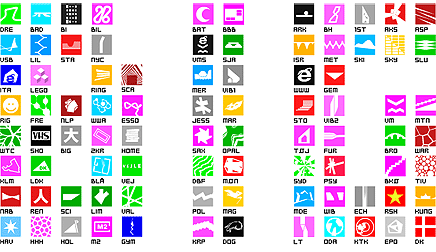
[Enrique Ramirez] You’ve been at your Nørrebro office for almost a year, and as
I am walking through your studio, I cannot help but notice the way your
practice uses iconography. Was this always a conscious part of your work?
[Bjarke Ingels] Yeah, I would like to think so. But it was never as
calculated as people would think. A while back, I was in Shanghai. PLOT had
just split up. I knew I was going to continue my practice. I was in the
process of finding a new name, and it was kind of hard. I had this idea of
giving the office a name that wouldn’t be my name. We had used “PLOT” for 5
years, and now we had to find another catchy name. So the thing I liked about
the name, Bjarke Ingels Group, was that it had the word “group”, as in “group
effort.” It was an acronym that was funny, at least in the Danish context. I
mean, we are a tiny country, and of course, BiG sounds a little bit
pretentious.
Having the right initials did not hurt.
(smiles) Of course not. But, there’s more. So, in Shanghai, we
discovered that a sign we had done for a client actually looked like the
character that means “People” in Mandarin. We then realized that the Mandarin
word for “Big” looks remarkable like the word for “People”, but with a line
drawn across it. It felt like destiny.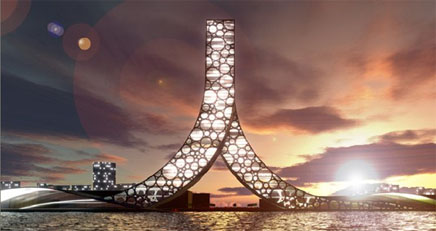
I won’t be the first to tell you that this is simply amazing branding.
It’s interesting to see branding fully integrated into the firm, in terms of
web design, the building, everything
Yes, but I think these things always occur accidentally, or maybe
during brainstorming. It’s really hard to find a new name, but once I found
out there was this weird relationship between the Mandarin script, our
company’s name and ideas, well, you can imagine our excitement.
But that word, “excitement” really describes something really compelling
about BIG. If you look at your work, your projects, there’s this incredible
mix of unquestionable legibility and clarity, and outright giddiness. You look
like you are actually having fun.
But it’s very serious. Like Monty Python would say, “we are serious
about being funny.” But there is some truth to that, you know. Having fun is
of course good for us. But it’s also important for the client. Having fun
means creating a climate where everybody is willing to push themselves, to go
a little bit further.
Indeed! Like this Lego site model. Can you describe it?
It was a competition for a mixed-use development. Well, essentially
it’s this very large development, 40,000 square meters, based near the
Copenhagen central station. The client required a 400 FAR, so this meant we
had to investigate different ways to increase density. Doing that is a
struggle. People here are skeptical of high rises … everything above 20 meters
is immediately “un-Copenhagen.” If you analyze the skyline here, you will find
out very quickly that a 400 FAR is near impossible without breaking the height
limit. I think we were facing an age-old problem, and therefore had an age-old
response. Until the beginning of last century, architects could actually
imagine really cool and interesting projects, but with demands of production,
economics, etc., it seemed that the only solution was a modernist box. I know
this may seen simplistic, but bear with me. Copenhagen is known as a city of
towers. What if you could combine the two things, the Copenhagen tower and the
modernist box, seeing their combination as an opportunity instead of as an
inhibition? Instead of starting by doing something unimaginative, instead of
trying to squeeze something irregular into a regular grid, we constantly
experimented with creating various any shapes. So in 3dMax, we made a carpet
that we pulled over the site, creating a low-resolution blob with peaks and
valleys – something very much like those pin shape puzzles you see
everywhere.
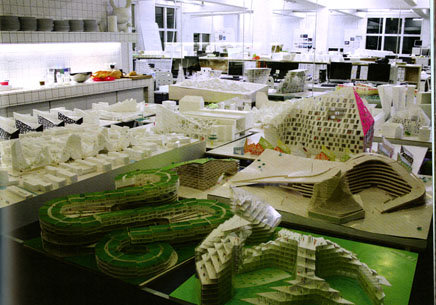

We like this project very much. On the ground floors you have parking, sky
lit shopping, becoming three floors of offices, becoming housing. It also
features this transition from the ground to the towers – a transition from the
arena-like public areas to the more private offices in the towered peaks.
And why are you building the model out of Lego pieces?
Perhaps it’s a tribute to modularity? Or a homage to the building
industry? Like our logo, we had another lucky moment. We found out that if we
build our context model in 1:500, we would essentially be matching the scale
of a single Lego figurine.
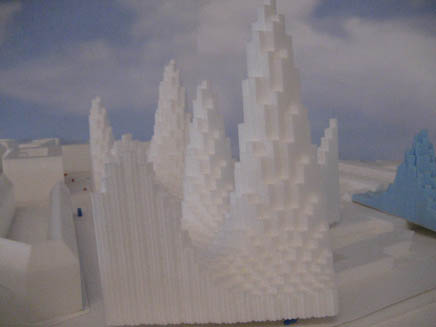
So we built the context model using this software you can download from
Lego. When you’re done with the model, you click “submit” and you pay. They
send you a box with a picture of your Lego model. So after we won this
competition, we got the idea to get Lego to sponsor the construction of a
model scaled to a Lego person. So they donated 220,000 Lego pieces. The
results will speak for themselves.
But at what point did the inspiration to use Lego become evident? At what
stage?
There are a lot of Copenhagen things – Danish things in this project.
We were actually thinking about Jørn Utzon, especially his idea of the
additive, that you could create any possible form out of a series of
industrially produced elements. This is basically the same thing. But we
wanted to take it further. We wanted to use two Danish icons, two things from
our childhood and our education – Utzon and Lego – and take it to extremes.
But it seems to me that a perfect example of BIG’s approach. Here we have
a design problem, and yet you have the capabilities to negotiate with
companies like Lego. Do you view BIG more like a consultancy than anything
else?
We just try to keep things interesting. A project becomes interesting
when it is an experiment. And once you formulate the plot, the starting
concept, what a project is about, it becomes infinitely easier to do it. It
sounds silly, and you are probably saying. “Duh!”, but you would be surprised
how far one can get along by treating a design problem like an experiment.
You start opening your mind to new possibilities. And this means that when
things become too rigid, you revisit the problem, and tweak it. You change the
parameters. And I think that at this point, the decision making process
becomes much more sound, and much more fun. So with this project, we never
began with the idea of a Lego branding exercise. Only when we started talking
about the modularity of Lego bricks, the popularity of the Lego brand, and the
fact that we are, first and foremost, a Danish company, then things began to
get interesting.
But your idea of keeping things interesting must certainly be related to
your own experiences as a studio instructor. The idea of “ecolomy” was
certainly a big part of your advanced studio at Harvard Design School, can you
tell me a little bit more about it? What do you mean by “ecolomy”?
Well, it’s a little different than Koolhaas’ use of the word in
“Junkspace,” I would like to think of “ecolomy” as a particularly Danish
thing. It began here in Copenhagen. We were working on an energy-related
project for the city. It was around the time of this conference about
consensus. The conference organizers invited all types of economists, and
together, they began to prioritize all of the world’s economic and
environmental issues in terms of price. People were appalled at the idea of
putting a price on the environment. But the sad truth is that if you don’t do
it, it won’t have any value to anyone. Whether you want it or not, you will
actually priortize things against each other.
The idea of ecology and economy, or ecolomy, offers a different spin on
this problem. It is a way of preventing a “good versus bad”, “philanthropy
versus capitalism”, “economy versus ecology” dichotomy. Looking at things in
these absolutes is quite harmful. Ecolomy is thus a way of thinking and
working. It goes beyond looking at things in terms of solely expenses and or
investments.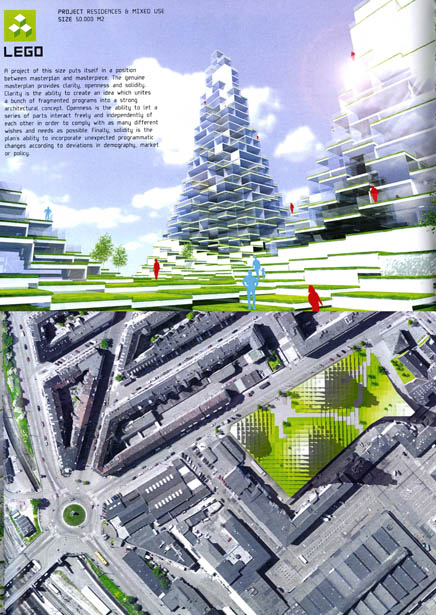
So it’s a systemic approach?
Exactly. And we try to incorporate it into our work. Our projects
continue to incorporate ideas about sustainability. But we don’t see
sustainability as this pious thing. It doesn’t have to hurt. In fact, our
choice of materials and systems for our buildings actually help reduce
maintenance costs and allow for longer life cycles.
Do you see this as a paradigm shift for architecture practice? Can you
elaborate a little bit on “ecolomy” and Danishness?
I think the Danishness of BIG’s practice, which I am fairly conscious
about, is a reaction to the egalitarian-ness of Danish culture. Everyone is
supposed to be heard. There is no culture of majority. It is a culture of
consensus, incorporating concerns of everyone. Traditionally this has lead to
a case of mediocrity, as evidenced by the fact that all Copenhagen’s buldings
are the same height. No extremes. Essentially, it creates a lowest common
denominator. Architecturally, this means the repetition of common square
boxes.
BIG is about finding ways to empower ourselves as architects and urbanists.
It is about thinking how all these concerns -- site, program, form, ecolomy --
can be wielded as a power. There is a zen koan that talks about making the
force of your opponent your own force. In terms of our project, we do not
compromise. We take all the demands and insist of solving every single one of
them. We think that, as with the Lego project, the result is infinitely more
adventurous than plain housing slabs. BIG is not about the power of
architectural genius. We explore the idea that collective interest is a viable
design power.
Perhaps this explains your interest in both public and developer-based
models.
I think so. We’ve had great success with our Kløverkarren project. We
actually had to act as a developer, entering into a contract with the City of
Copenhagen, to finalize this project. We designed a superstructure along the
perimeter – a 3km long building that surrounds a network of sports fields.
But this is not easy. I have been traveling for the past six weeks trying
to sell this project. And at this point, you begin to see how being an
architect means that you have to be a little bit of a politician. You become
too familiar with codes, laws, and how they can be limiting.
Do you think that architects can use their expertise to change these
laws? Do you see a need for BIG to go beyond a developer model and enter the
realm of advocacy? How complicated an issue is this?
I would like to think of it as being rather simple. When it comes down
to it, the mechanisms behind all these systems – legal or institutional -- are
simple. I recently read Ray Kurzweil’s book Singularity is Near , where
he defines complexity in a very nice way: complexity is the ability to convey
the maximum amount of information with the minimum amount of data. So
complexity is a form of simplicity. BIG is about the complex, not the
complicated. There’s a difference. Einstein said something like “Don’t
simplify things, make simple things.”
So for a designer, simplicity can be this very subjective thing. One
person’s complexity is another’s simplicity. Take the Lego project, for
instance. In one sense, the idea of using Lego bricks seems rather simple or
facile. But in fact, it entails a very nuanced business savvy – an
appreciation for the corporate sphere.
Perhaps. Have you seen ICON magazine? Our manifesto is entitled
“BIGAMY.” It’s about the ability to have things your own way, on your own
terms. It was a manifesto for this essentially Danish approach. It was our way
of saying fuck the budget, fuck the rules, fuck the context. You do not have
to define yourself as a revolutionary against the establishment. If you decide
to be a radical against someone else, essentially you are a radical in
reverse. So perhaps there could really be something radical about pleasing
everybody.
Do you see any opportunities to explore this idea in the future? Do you
think that this is something worth negotiating in an academic setting, or in
professional practice?
Well, there may be an opportunity very soon, at the Architectural
Association in London. I’m talking with people about teaching a studio there.
The topic would be the 2020 Olympic Games in Copenhagen – a hot discussion
topic there right now. It would be an opportunity to further press the ideas
of ecolomy, sustainability, consensus, complexity. You can pass legislation
such that all large-scale buildings should have low energy consumption, you
can even mandate zero-energy buildings. But this will never change the fact
that Copenhagen has already been built. To really think about sustainability,
to think ecolomically about it, you need to exploit the syntheses of programs
at a massive level, at the urban level. This means integrating the flow of
infrastructures into a viable design strategy. In other words, what if all
investments for the 2020 Olympic Games can be marshaled to make Copenhagen the
world’s first 100% ecolomical capital?
That seems daunting.
But it’s worthwhile. You have to look at things anew. Take new
approaches. Once you have done that, great things will happen.
Creative Commons License
This work is licensed under a Creative Commons License .
/Creative Commons License
19 Comments
great timing! the BIG event at Storefront last night, coinciding with the release of this interview...the timing is especially useful because the focus of last night was beer drinking and casual architecture model perusing. this interview adds significant content to the overall experience. Thanks Enrique, great intro and questions.
Bjarke Ingels will be talking about his work on Thurs night in conjunction w/ the Storefront show:
IN CONVERSATION: Bjarke Ingels and Mark Wigley
Thurs, Oct 4
Van Alen Institute
6:30pm
http://www.vanalen.org/events/BjarkeIngels_MarkWigley
Once again an Architect who is getting into development and sees this trend as the way forward...
As has been argued in forums and elsewhere it certainly gives the architecture a "greate rlevel of control" at least in terms of development of a program....
It will be interesting to watch and see if more and more follow this trend...It is at the least an opportunity for architects to make more money, out of any project.
Also,, i was struck by the answer below.
"Perhaps it’s a tribute to modularity? Or a homage to the building industry? "
He is not even sure why they did it..Symbolism without meaningful intent...
Is that even possible.
Fascinating interview, Enrique. Ecolomy....I will have to bookmark this for my thesis research.
great interview enrique... i just returned from the ifhp world congress in copenhagen on saturday... while i was there i had the opportunity to take a quick tour of the VM houses with one of the architects from PLOT/BIG... i also saw "the mountain" which is under construction right next door... i can't recall his name, but he was a great guy... i really enjoy their work... there is a lot of great stuff happening in cph right now.
actually i think that is him in the long sleeve gray shirt in the center of the picture of the big model... he lives in one of the VM units...
I would be interested in the financial success or otherwise of Ingels practice. We never hear the details of money, turnover, investment, return, or financing in regards to architecture practice in general.
I am wondering how BIG's approach differs from traditional practices in terms of their revenue stream.
I appreciate BIG's approach, but I wonder whether it is built on a genuine unique business model that is sustainable and duplicatible, or whether Ingels' practice has some other financial support that allows the degree of experimentation that is seems to indulge in.
Dont get me wrong - I believe in architect as developer - and BIG is doing some amazing work. I want to emulate them, but I want to know if it can be done and how...
there was an article about PLOT as a business and how close they were to going under, how they had no commissions and sort of made their own (interestingly Ando did this once too, and Steven Holl tried but failed)...someone here might recall the link. it was interesting cuz they are honest (seeming anyway) about their business and how it has gone so far.
unique? i don't know. maybe. certainly they are trying to do new things and willing to go whichever way necessary to get there...that is maybe what is new. i find them also quite fresh cuz they don't seem to have a feeling of entitlement, of deserving the work they do. they work to get it. that is impressive.
Well these are the details that I think are important. I would be interested in seeing that article on PLOT.
I can understand a young architectural practice inventing its own 'commissions', briefs, and projects as an intellectual and marketing endeavour - this is commonplace and serves a variety of purposes. MVRDV did/do it, Koolhaas did/do it etc, etc. Whatever resources it takes to do this are written off in terms of the publicity and knowledge it brings in.
What I am trying to figure out is whether BIG are operating from a different [maybe not unique] business model, and if so what is the basis of that model and is it successul, or underneath it all are they a 'regular' practice with a whole lot more marketing and branding savvy.
Again, I am a LARGE fan of BIG, and I want them to succeed.
I do love these archinect features, always pushing the nose of architectural discourse. Thanks for this.
Interesting too I might add the slant of discussion after, more about the financial/business side of BIG as a concept for practice. Great stuff
more like this please.
IN CONVERSATION: Bjarke Ingels and Mark Wigley
last night at the Van Alan Institute (thanks for the heads up, it was an entertaining and informative event).
he's wearing a kraftwerk t-shirt
I wonder if this "Danish" model is exportable to other European nations or other nations generally. Certainly in DK, "ecolomy" makes perfect sense: the Danes are hyper-sensitive to environmental issues. It makes sense elsewhere, too, but would such a model be as well-received in, say, Shanghai or Sao Paulo or Philadelphia? One can only hope...
Risk was produced by Parker Brothers, not Milton Bradley. Hail the Instant Icon.
Vado .... both Milton Bradley and Parker Brothers are wholly-owned subsidiaries of Hasbro. Hail the instant icon indeed.
yes but my risk experience predates the hasbro buy out.
touché, Vado
So, no further comments on the financial and administrative structure of the BIG practice? - still waiting....
Block this user
Are you sure you want to block this user and hide all related comments throughout the site?
Archinect
This is your first comment on Archinect. Your comment will be visible once approved.